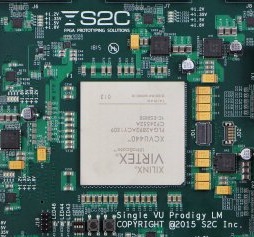 I haven’t sat down to speak with S2C since we collaborated on the book, PROTOTYPICAL, published just before DAC 2016 and even then, I hadn’t spoken to Toshio Nakama, their CEO. Toshio splits his time between the San Jose headquarters and the Shanghai headquarters so getting time to meet face-to-face has been challenging. I was finally able to sit down with him to discuss the latest in FPGAs and prototyping and what’s next for S2C. Here is a snapshot of our discussion.
I haven’t sat down to speak with S2C since we collaborated on the book, PROTOTYPICAL, published just before DAC 2016 and even then, I hadn’t spoken to Toshio Nakama, their CEO. Toshio splits his time between the San Jose headquarters and the Shanghai headquarters so getting time to meet face-to-face has been challenging. I was finally able to sit down with him to discuss the latest in FPGAs and prototyping and what’s next for S2C. Here is a snapshot of our discussion.
How Has FPGA Prototyping Evolved and What’s Next?
Toshio: FPGA prototyping has traditionally been thought of as an adjunct to emulation – something that was nice to have but because of its complexities of employment was never fully adopted. Times have changed however, FPGA prototyping has become much easier to use and because of increasing design complexity it has become a must-have tool in the design and verification flow. Partitioning the design has always been one of the hurdles to adoption, but FPGA partition tools have advanced to handle even the largest designs while FPGAs themselves have increased in capacity to reduce the number of FPGAs needed.
As to the second part of your question, FPGA prototyping is being used more and more by dispersed design and verification teams. No longer are singular teams all sitting together in the same room or the same office for that matter. To accommodate this FPGA prototyping must take to the cloud and allow globalized teams to share resources. In fact, FPGA prototyping solutions must also allow teams working on multiple designs to share resources and not limit the shared resources to a single design or instance.
What Is Unique About S2C?
Toshio: We are experts in FPGA prototyping. We are proud to have the largest team dedicated to the technology of FPGA prototyping. Our expertise comes from the development of hundreds of customized prototyping environments that have created a very robust engineering knowledge base for developing reliable, easy-to-implement, and extremely efficient solutions. We have consistently made sure to push the boundaries of what FPGA prototyping can do so that our customers can gain a competitive advantage.
Through our many interactions with customers, we’ve realized that scalability is a key component. Our customers’ complex designs have given rise to untethered scalability. Increased I/O counts, significant memory throughput, and a large number of DSPs have become commonplace.
How Do Designers Get the Most Out of FPGA Prototyping?
Toshio: There are many ways for that to happen. One significant solution is to make FPGA prototyping part of your overall design process. I believe, Mon-Ren Chene, our CTO, mentions this in the book that you published. Designers can benefit greatly by designing with prototyping in mind. Doing so will speed up the prototyping process down the road and help with synthesis, partitioning and debug. As we outlined in the book, there are six ways that designing for prototyping can be achieved: Prototyping-friendly design hierarchies, block-based prototyping, a clean and well-defined clock network, memory modeling, register placement, and avoiding asynchronous or latch-based circuits.
Do You See FPGA Prototyping Expanding Its Role Beyond SoCs?
Toshio: Advances in FPGAs has opened the door to new areas of adoption. We’re seeing the benefits for areas related to high-performance computing and artificial intelligence. We’re already addressing the HPC market with our upcoming unveiling of our Prodigy Arria 10 Logic Module. We’re excited to see that the benefits of FPGAs can be realized beyond traditional markets. Stay tuned for lots more to come from S2C on these fronts.
About S2C
Founded and headquartered in San Jose, California, S2C has been successfully delivering rapid SoC prototyping solutions since 2003. S2C provides:
- Rapid FPGA-based prototyping hardware and automation software
- Prototype Ready™ IP, interfaces and platforms
- System-level design verification and acceleration tools
With over 200 customers and more that 800 systems installed, S2C’s focus is on SoC/ASIC development to reduce the SoC design cycle. Our highly qualified engineering team and customer-centric sales force understands our users’ SoC development needs. S2C systems have been deployed by leaders in consumer electronics, communications, computing, image processing, data storage, research, defense, education, automotive, medical, design services, and silicon IP. S2C is headquartered in San Jose, CA with offices and distributors around the globe including the UK, Israel, China, Taiwan, Korea, and Japan. For more information, visit www.s2cinc.com.

Also Read:
CTO Interview: Mohamed Kassem of efabless
IEDM 2016 – Marie Semeria LETI Interview
CEO Interview: Dündar Dumlugöl of Magwel
Share this post via:






Comments
There are no comments yet.
You must register or log in to view/post comments.